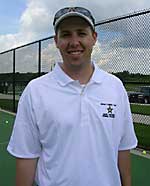|
TennisOne Lessons
Seven Doubles Principles for USTA League Players Low you go on the Secondary Poach, Part III By David Brouwer
In my last article, I wrote about the importance of going with the flow of your body and sticking with high percentage shot selection as you‘re playing a doubles point. In this article, I'd like to focus on the recognition of the secondary poach and what to do when this opportunity comes up in a doubles match. Many USTA league players understand the concept of poaching in a doubles match. At our clubs, however, very few understand the concept of the secondary poach. Therefore, they fail to recognize when this opportunity arises. So what is a secondary poach? A secondary poach is when the returner's partner recognizes that a good return has been struck and the server will have to volley or groundstroke the next ball up and across the middle of the court. The returner's partner cuts across to pick off that volley or groundstroke and plays it close to close (at the opposing net player), following the first principle I wrote about in this series. The reason we call it the secondary poach is because it is the second opportunity in the point for a player to poach. The first is when the server's partner cuts off the return of serve. So how does a player recognize this opportunity? When the return is struck, the returner's partner should be paying attention to three things. They are:
If any of these three things looks defensive, there is an opportunity for a secondary poach. The key for the returner's partner is to recognize this immediately and move forward with the intent to pick off the next ball the server hits. Understanding this opportunity is the first key to some free doubles points. The second key is understanding the concept of “hunting” at the net. Let me explain. Hunting is when the net player continuously moves forward and backward inside the service box looking for the chance to pick off a secondary poach. When the ball is being struck by the server, they're moving forward. If the server keeps it away from them, they back up a step to judge the quality of their partner's next shot. This movement continues until they're able to get their racquet on a ball and go close to close at the opposing net player. Since this movement and the concept of secondary poaching are so important, you'll want to drill them in practice. Following are two drills that I find successful at our club to teach players the secondary poach: Keep away doubles With four players on a court in a one up/one back setup the baseliners start a crosscourt rally. The two net players are hunting for the volley by moving forward when the ball is in front of them and moving backward when their partner is hitting. When a net player is able to get a racquet on the ball, they go close to close at the other net player and the point is played from there. Play side against side games up to 7 or 11 and then rotate one spot to the right on the court.
Kamikazee In this drill, there are two teams of three on the court. Each team of three has two players on the baseline and one at the service T (two back, one up). A ball is put into play to either baseliner and played out. If the net player wins the point by picking off the ball, their team is awarded three points. All other points are only worth one. So the baseliners are trying to keep it away from the kamikazee's at the net. This drill really encourages movement at the net and the diagonal movement that is necessary to poach and secondary poach effectively. Play games up to 15 and then put a new kamikazee at the net. Remember, many USTA league players have technique that may never change. But their ability to use high percentage doubles principles can increase their ability to win matches despite technical limitations. Understanding the concept of the secondary poach and being able to recognize it in a match situation will surely win you more doubles points! See you on the court. Your comments are welcome. Let us know what you think about David Brouwer's article by emailing us here at TennisOne.
David was voted the USPTA Michigan Professional of the year in 2002 and has won two USPTA Outstanding Education awards. David has been a speaker at the USPTA Midwest and National conventions and is the Director of the West Michigan Tennis Academy. David coaches USTA league players of all levels and finds great joy in coaching strategy and tactics to build smarter tennis players. |

 David Brouwer, USPTA is the Director of Tennis for three major health clubs in Grand Rapids , MI.
David Brouwer, USPTA is the Director of Tennis for three major health clubs in Grand Rapids , MI.